Massimiliano Pagliara In Conversation With FAULT Magazine
Massimiliano Pagliara X FAULT Magazine
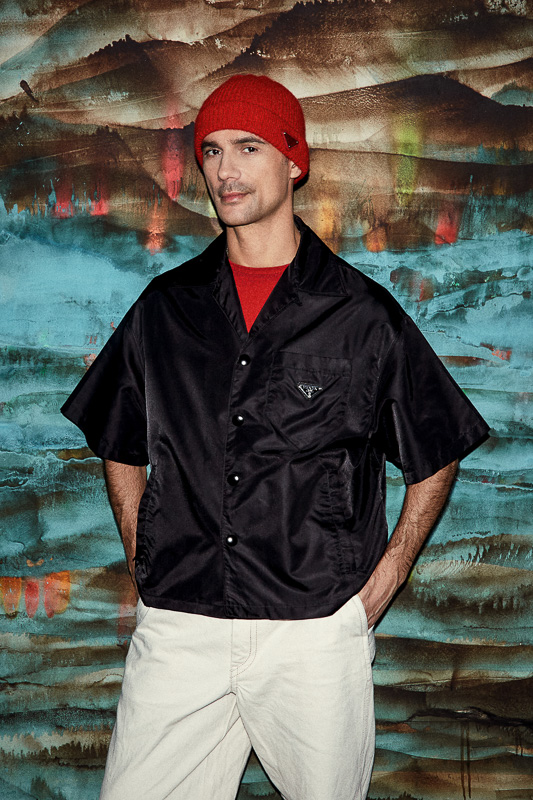
ECLECTICISM BETWEEN DANCE AND MUSIC
Photographer Stefano Righi
Styling & Art Direction Valerio Torre
Special thanks to Maria Luisa Conserva
Special thanks to Maria Luisa Conserva Casa Giuba
Words: Valerio Torre
In a spacious loft on the outskirts of Milan, I’m waiting for a DJ and producer who is a prominent figure in Berlin’s electronic music scene and a resident at Berghain/Panorama Bar in Berlin, Robert Johnson in Offenbach, and Basement in Brooklyn. His work includes releases on labels such as Live at Robert Johnson, Permanent Vacation, Ostgut Ton, and his own imprint, Funnuvojere Records. His sound is as eclectic and energetic as his personality. Massimiliano Pagliara has arrived. Known as “Massi” to his friends, he was born in Tricase, in the province of Lecce, but has been a Berliner by adoption for decades now. When he is not in the German capital, he is traveling all over the world. We met him in Milan during one of his tours and had a little chat with him.
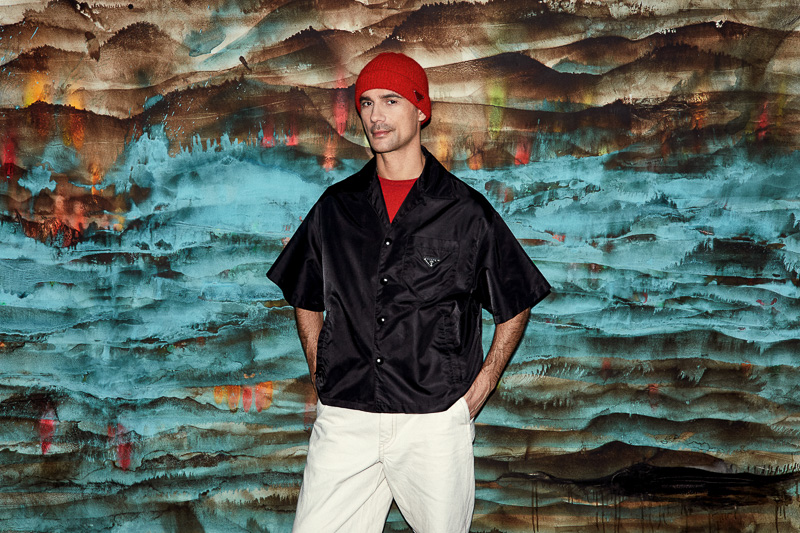
Hi Massi! After establishing a symbiotic connection with music for so many years, we would love to delve deeper into your journey by exploring your experiences further. How long have you cultivated this connection with music, and how has it influenced your artistic growth?
Massimiliano Pagliara: I have a deep connection with music that began in my adolescence and continues to this day. Music has been a guiding thread in my life, connecting different periods and the important people I’ve met along the way. Each phase of my life has been marked by a specific music genre, like reggae and hip-hop from ages 13 to 15. From 16 to 18, I went through an indie-punk-rock phase. From 18 onwards, I started exploring more electronic territories, beginning with drum ‘n’ bass and eventually moving to techno and house. This was in the late ’90s. I had moved to Milan from Puglia to study theatre and dance. During the week, I trained non-stop, and then on weekends, I would go dance at these illegal drum ‘n’ bass/breakbeat raves. Music has always shaped what I did and has been a great source of inspiration. I’ll never forget the moment I first saw the video for “Come To Daddy” by Aphex Twin. I went to see an exhibition on digital art and new technologies in Milan. At the time, I was working on my first choreography, “Il Bagno Di Diana,” and both Cunningham’s video and Aphex’s sounds struck me deeply, significantly influencing the research project I was conducting. From that moment on, I realized that music was something very special, and I couldn’t live without it. However, I was still a dancer and choreographer at that time. It was only after moving to Berlin and immersing myself in the city’s explosive techno nightlife that I began to fantasize about becoming a DJ.
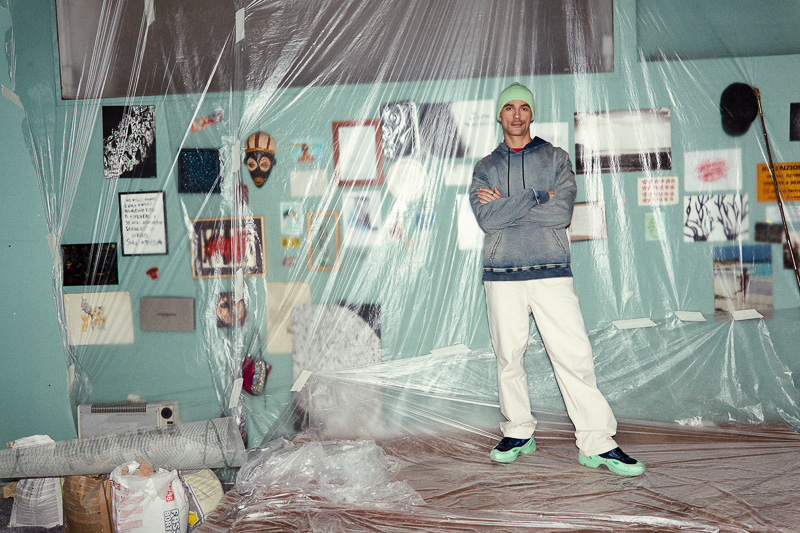
Sweatshirt Diesel
Trousers Prada
Shoes Raf Simons
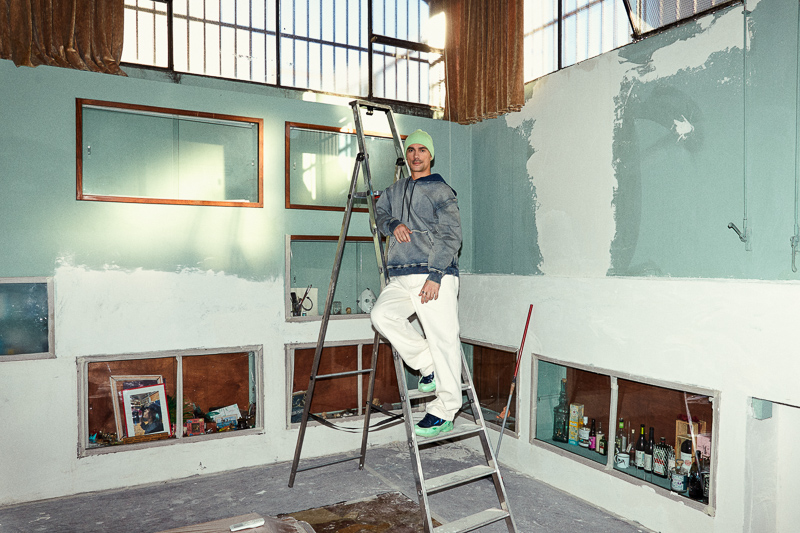
Sweatshirt Diesel
Trousers Prada
Shoes Raf Simons
Speaking about your sound aesthetic, how would you describe it? Do you have specific musical references that guide your style? Additionally, what inspires you in music creation? Where do you draw your source of inspiration from?
Massimiliano Pagliara: Because I have gone through all these phases in my life and have been drawn to so many different genres, it’s not easy to define my sound. It’s definitely very eclectic. It spans various facets of electronic music, from Chicago house to Italo-disco, with shades of Detroit electro, techno, ambient, trip-hop, and New York minimalism. When I’m in the studio, I create what I feel at that moment, without thinking I need to follow a specific genre or style, and without adhering to strict rules. There’s also the “Massi old-school” aspect since I primarily work using hardware from a certain era. I’m very attached to my beloved old machines from the ’70s and ’80s, which naturally give my music a somewhat retro connotation. However, I strive to create something that truly reflects my personality. Additionally, I have many interests that range from art, interior design, and architecture, to fashion and cinema. These are all sources of inspiration that I draw from and that greatly help me during my creative process. I constantly find new inputs and try to remain as open as possible.
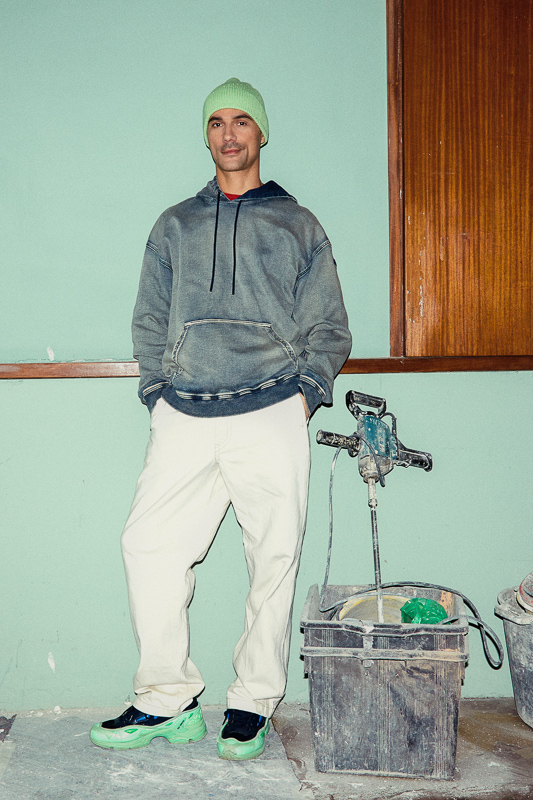

Sweatshirt Diesel
Trousers Prada
Shoes Raf Simons
Besides music, you have pursued a career in dance. We would love to know what the relationship is between these two art forms in your experience. Is there a connection between dance and your music production? How do these two spheres influence each other in your creative work?
Massimiliano Pagliara: As a child, I wanted to be a dancer, but growing up in a small, conservative town in Puglia, there were no dance schools for boys, so I abandoned that idea. Meanwhile, I began to love and listen to a lot of music, which became a way of life for me and a means of escaping the harsh reality of provincial life. When I moved to Milan for my studies, my first roommate was a dancer and dance teacher. He introduced me to the world of dance, which had always fascinated me, and I was finally able to dedicate myself to this discipline. I enrolled at the Paolo Grassi Civic School of Theatre and Dance, where I had the opportunity to work with exceptional choreographers, including Susanne Linke. At the same time, I continued to discover new music (it was the Warp Records electronic phase), which I used during training and choreographic studies. From that moment on, electronic music and dance became perfectly interconnected and inseparable. After moving to Berlin and starting to DJ, there was a phase of deep experimentation in which I combined the two disciplines. I performed in art galleries, DJed while projecting a video performance that I had filmed and edited, featuring myself dancing. It was an audiovisual work. Unfortunately, despite my love for it, I had to abandon dance to focus exclusively on music. This happened in 2006, marking the beginning of my music production career. However, I still feel that dance is part of my life and has a certain influence on what I do as a music producer. I think my music always has a certain theatricality, atmosphere, story, and sense of movement. When I am in the studio composing, it is as if I am on stage choreographing. The same happens when I am behind the DJ booth: I am mixing music but also moving a lot. This creates an incredible exchange of energy, which in turn generates strong emotions and new creative stimuli.
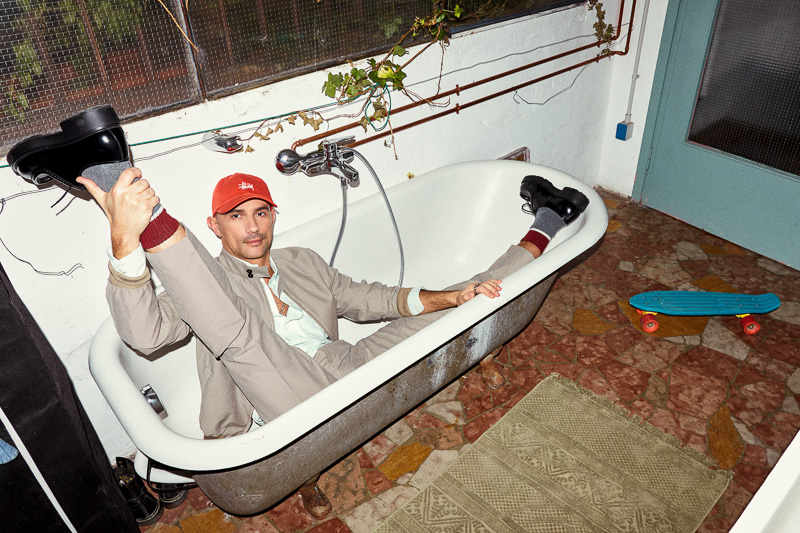
Sheos Prada
In the creative world, an artist’s style often reflects his or her personality. Can you tell us a little about your relationship with fashion? How would you define the importance of fashion in your artistic expression, and how do you integrate it into your personal style?
Massimiliano Pagliara: My mother owned a clothing store. As a child, I loved trying on various outfits and enjoyed styling the two mannequins that were in the shop window. So, I would say that my attention to and passion for fashion started in my childhood. As a teenager, I began to follow the first brands and developed a personal style. I started to understand that clothing had a significant impact on me: the color or cut of the clothes I chose could influence my mood and actions for the day. Over time, I became very attentive to the clothes, furniture, and objects that surround me. I like to create an environment that inspires me, and wearing clothes that make me feel comfortable helps me reflect, write, and compose. So, fashion definitely influences my creative process. Moreover, when I watch a Prada or Margiela show, two of my favorite brands, I find something so aesthetically strong and intellectual that I always think of it as art. The theatricality, the atmosphere, the choice of fabrics and colours, the soundtrack, the space, or the movement of the models are all elements that offer very strong inputs that can contribute to the creation of a new track. I believe there is a lot of complementarity between the two fields, fashion and music. They influence each other. Music is a fundamental part of a fashion show, and I look with interest at the work Michel Gaubert has done over the years, for example, or at a new duo of designers, JordanLuca, who have drawn from the London rave clubbing scene to create their own aesthetic and narrative.
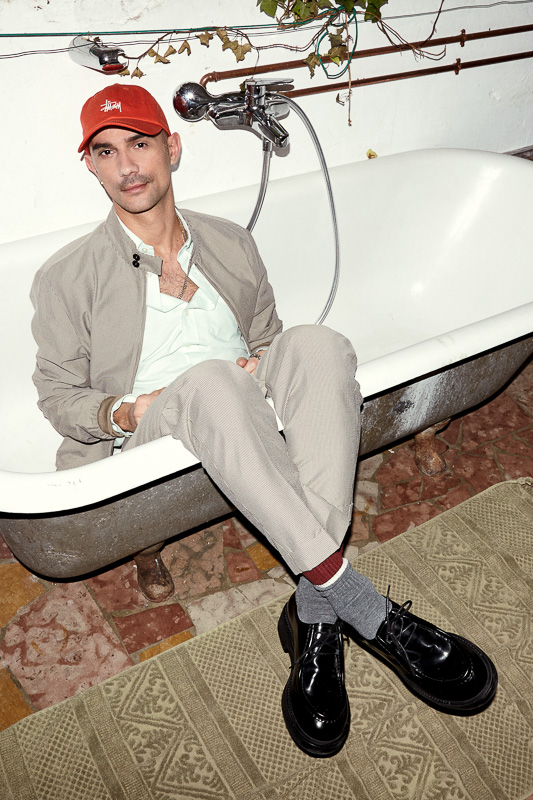
Sheos Prada
Considering the increasing importance of independent labels in the music scene, we would like to focus on your personal project, “Funnuvojere.” Could you share more details about this project and, in particular, tell us about your latest EP titled “All The VCOs You Can Eat”?
Massimiliano Pagliara: I started this chapter of the label in 2019 because some friends or fans would send me tracks to listen to and provide constructive feedback. Very often, while listening to these tracks, I thought that if I had my own label, I could release them. So, I decided to embark on this new adventure. The name comes from one of my favorite beaches in Salento, where I often go swimming in the summer when I visit my family. It’s a difficult beach to reach, and the sea is quite deep. The water has incredible colors, with brilliant shades of blue and green.
I have released music from eighteen artists so far. The latest EP by Eluize, “Curious Bliss,” came out in July, featuring two disco reworks by me. What I’m trying to do with Funnuvojere is what I also do as a DJ and producer: express my love for music and maintain a certain open-mindedness in terms of style. I listen to music without prejudice. In fact, I listen to everything. If I like something, I can play it or, in the case of the label, release it, regardless of the genre. It could be a techno track at 140 bpm or a trip-hop track at 98 bpm.
My latest single, “All The VCOs You Can Eat,” is a sort of homage to a great master, Manuel Göttsching. When I first heard E2-E4, I was completely fascinated. It’s a record I bought in various formats: vinyl, CD, digital, and I’ve listened to it many times at different moments, and it has always deeply moved me. Göttsching recorded this masterpiece in 1981 during a jam session of about an hour, simply pressing “record” on the tape machine and playing the various instruments live, as if he were performing in front of an audience. With this same spirit, I worked on my single, using nearly all my machines during a very long jam session (about 90 minutes). Of course, there was also a lot of editing work involved. Fortunately, today we can take advantage of new technologies, computers, and DAWs, which make this process much faster.
My dear friend Ben Ross Davis from New York created a wonderful design for this project. Next up is my new EP, “Hooking UP,” which will come out in October and features four tracks, ranging from house and acid to cosmic Italo-disco. It’s very much inspired by David Hockney’s paintings, Derek Jarman’s movies and journals, and Richard Cabut’s “Disorderly Magic.” The French artist Grav Jonz made a beautiful cover for this.
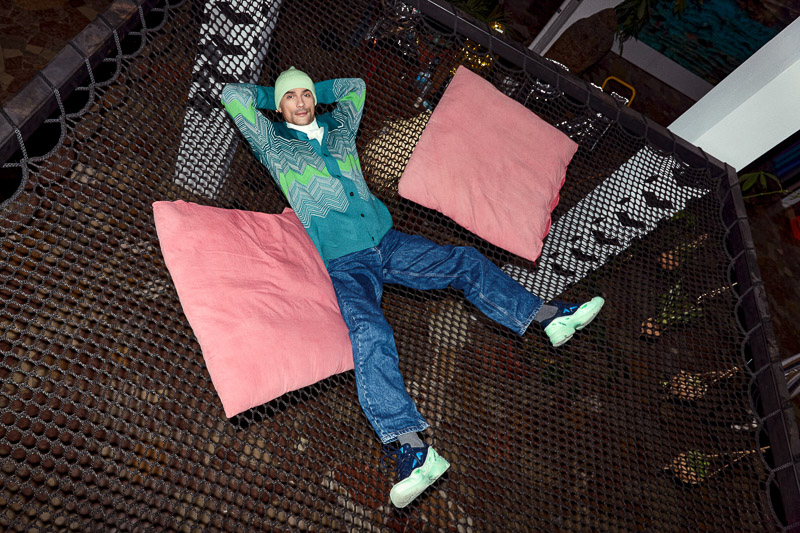
Shirt Cruna
Cardigan Missoni
Trousers Dries Van Noten
Shoes Raf Simons
Beyond the purely work-related aspect, music often acts as a social glue, especially in spaces, clubs, and events around the world. Considering the importance of creating a community in the music field, how important do you think it is to build true communities within the music scene?
Massimiliano Pagliara: I believe this is very important and one of the many powers of music. It brings different people together, regardless of their social status, age, or sexual orientation. It makes us all feel equal and respectful of each other. In this sense, clubs should always be “safe spaces” where everyone can be themselves and express themselves freely. This is something I noticed right away when I first arrived in Berlin in 2001 and went to OstGut (the former Berghain): for the first time, I felt this sense of “community” in a club. Very diverse people—gay, straight, queer, young, and older—celebrating together without any kind of problem, united by their love and passion for high-quality electronic music.
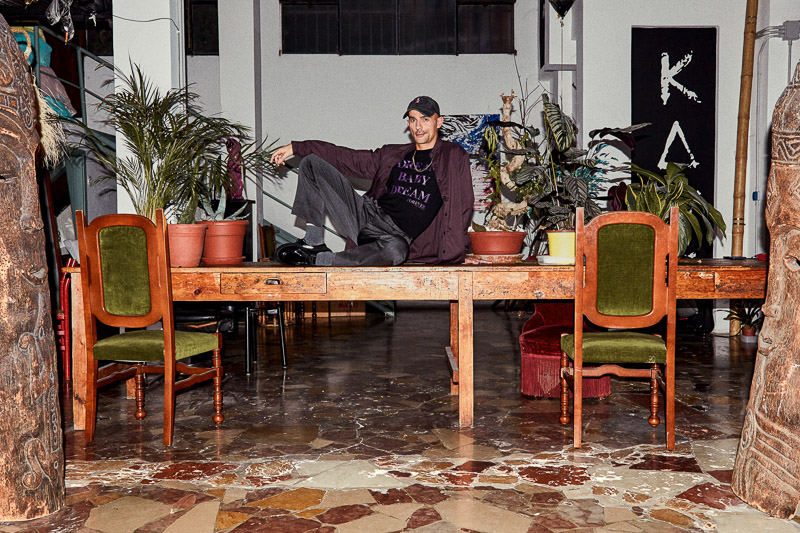
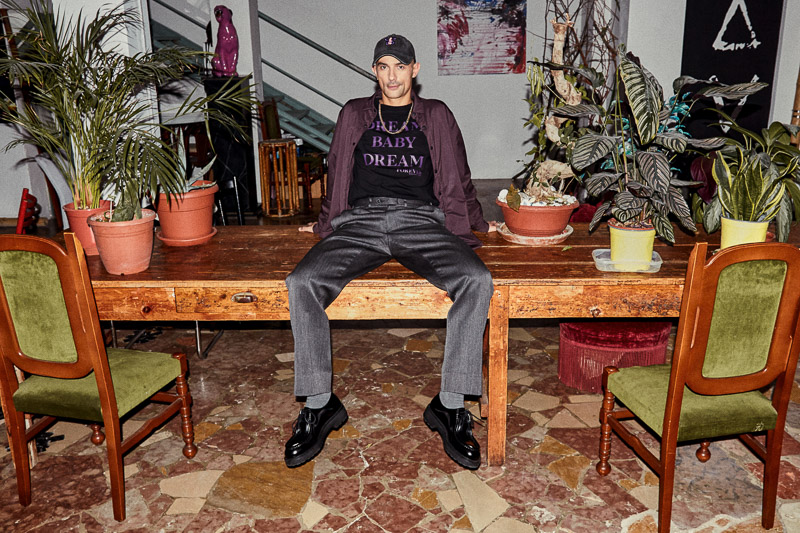
T-shirt Dries Van Noten
Trousers Prada
Shoes Prada
Today, the strong presence of electronic music is generating considerable interest among young people who are approaching this fascinating universe. What advice would you give to a young aspiring artist who wants to pursue a career in electronic music, considering your journey and experience?
Massimiliano Pagliara: If you have a certain passion, you simply need to follow your instincts and fully dedicate yourself to what you want to do. Like any other artistic discipline, it is a complex path that requires a lot of work and discipline. For aspiring young DJs, I would say they should have the means at home to practice the art of mixing: two turntables or CDJs and a mixer. I started by going to friends’ houses who had turntables and taught me a few things; then I started mixing every day. The turning point came when I finally managed to have my own turntables at home. I spent my days between dance classes and several hours of mixing behind those decks, recording my sets on cassette. It’s a matter of practice but also of a lot of listening. And to reach that kind of awareness, it takes some time.
The same goes for aspiring young producers: understanding what kind of approach or direction one feels like taking, whether more software or hardware, and getting down to playing. When I decided to start producing, the hardware approach, using machines like synthesizers and drum machines, was the most natural for me. Coming from dance, which is a very physical and tactile discipline, the idea of making music by playing a real instrument was more fascinating and interesting. So, I started buying my first synths, organizing my studio, taking piano lessons, watching tutorials on YouTube, reading manuals, asking more experienced musician friends, and then simply locking myself in the studio, playing, and recording for many hours. I did not attend any sound design or sound engineering school. Everything I know now comes simply from doing and experimenting with various things. It definitely takes some patience and discipline. When you really want to achieve something, it can happen.
We are curious to know about your short-term projects. Are you currently working on any specific future projects in the world of music or other artistic fields? Do you have anything particular in the works that you would like to share or preview?
Massimiliano Pagliara: Massimiliano Pagliara: Between all my travels, when I’m home in Berlin, I try to focus as much as possible on my studio productions. Currently, I’ve finished several remixes that will be released soon on various labels, a new EP (“Hooking Up,” mentioned above) that will come out in October on Funnuvojere. I’m also working on a major project, a sort of anthology/retrospective of Massimiliano Pagliara, in anticipation of my first 20 years of production, which I will celebrate in 2026. It includes a lot of material, both old and new, unreleased tracks, and early experiments that I’m producing and assembling.
We believe that the music one listens to can provide a significant representation of their personality. Could you share with us some tracks that you think define your essence?
Massimiliano Pagliara: This question is not easy at all, given the vast amount of very diverse music I’ve listened to over the past 30 years that has been life-changing for me. Anyway, I’ll try to provide a more recent list:
List of 15 tracks:
Aphex Twin – Ambient Selected Works Vol. 1 Global Communication – Transmissions
Orb – UF ORB
Massive Attack – protection
Nils Frahm – All Melody
Steve Reich – Music For 18 Musicians Larry Heard – Alien
Dream 2 Science – Dream 2 Science Patrick Cowley – Mind Warp
Giorgio Moroder – Evolution
Arthur Russell – Calling Out Of Context Sade – Diamond Life
Master C & J – Face it
Phuture – Acid Tracks
The Other People Place – Lifestyles Of The Laptop Café
PS: There is no order of importance!
What is your FAULT?
Not having started to play piano when I was a little child. My parents tried really hard to convince me but they didn’t succeed. I wanted to be a dancer and wanted to go to a ballet school instead. I ended up doing neither and nowadays, I often think, that if I had started playing piano back then, I could be capable of more complex harmonies when I work on new tracks. But who knows? Perhaps if I had started playing an instrument as a child I would be bored by now, and would not want to have anything to do with music all together.